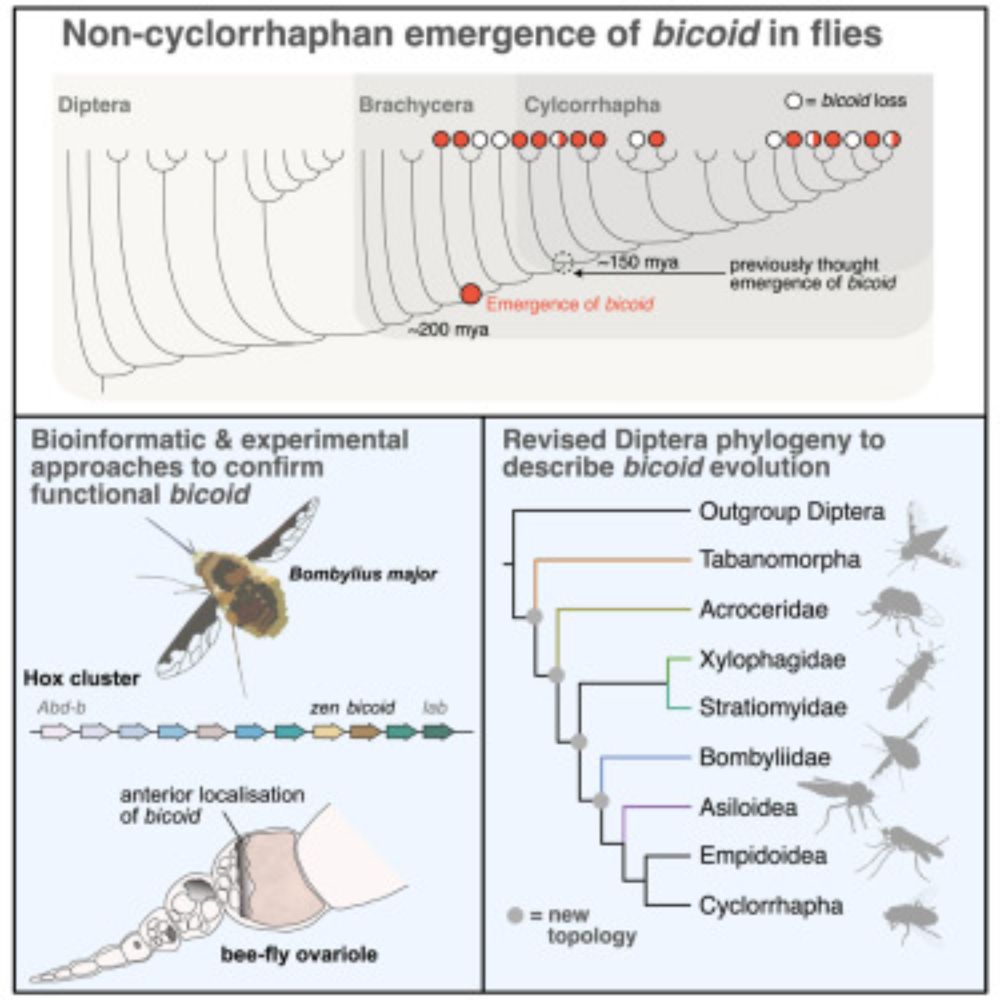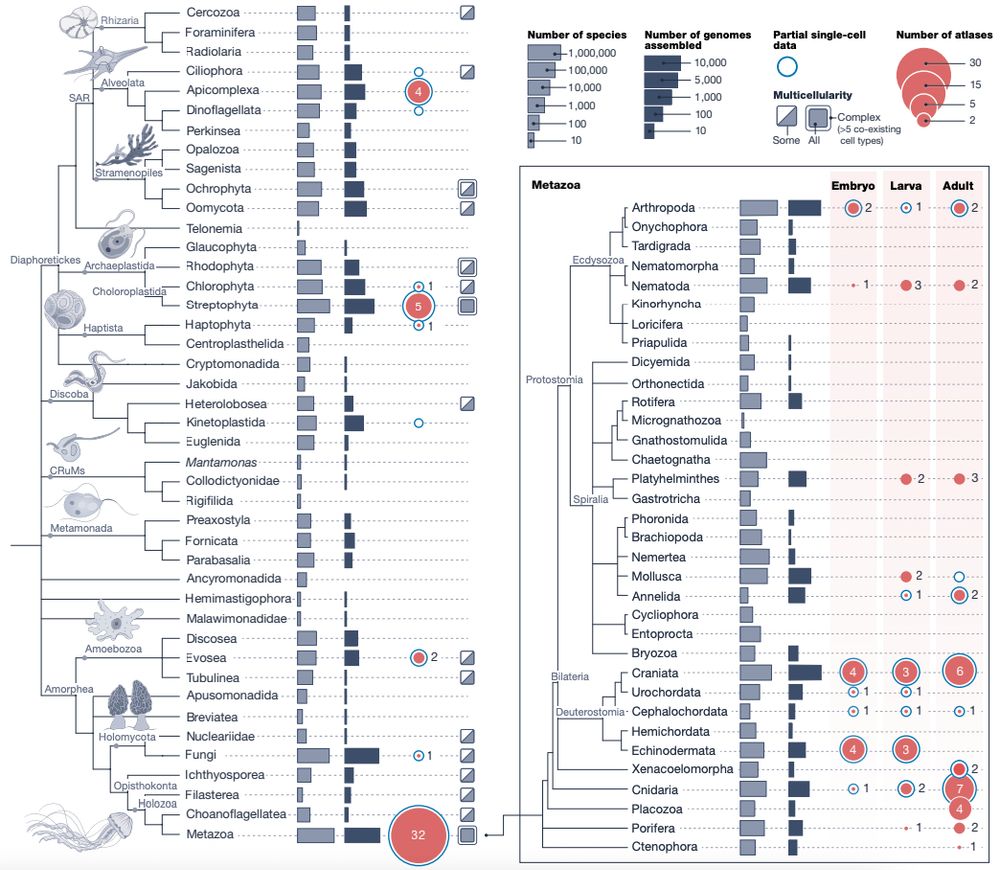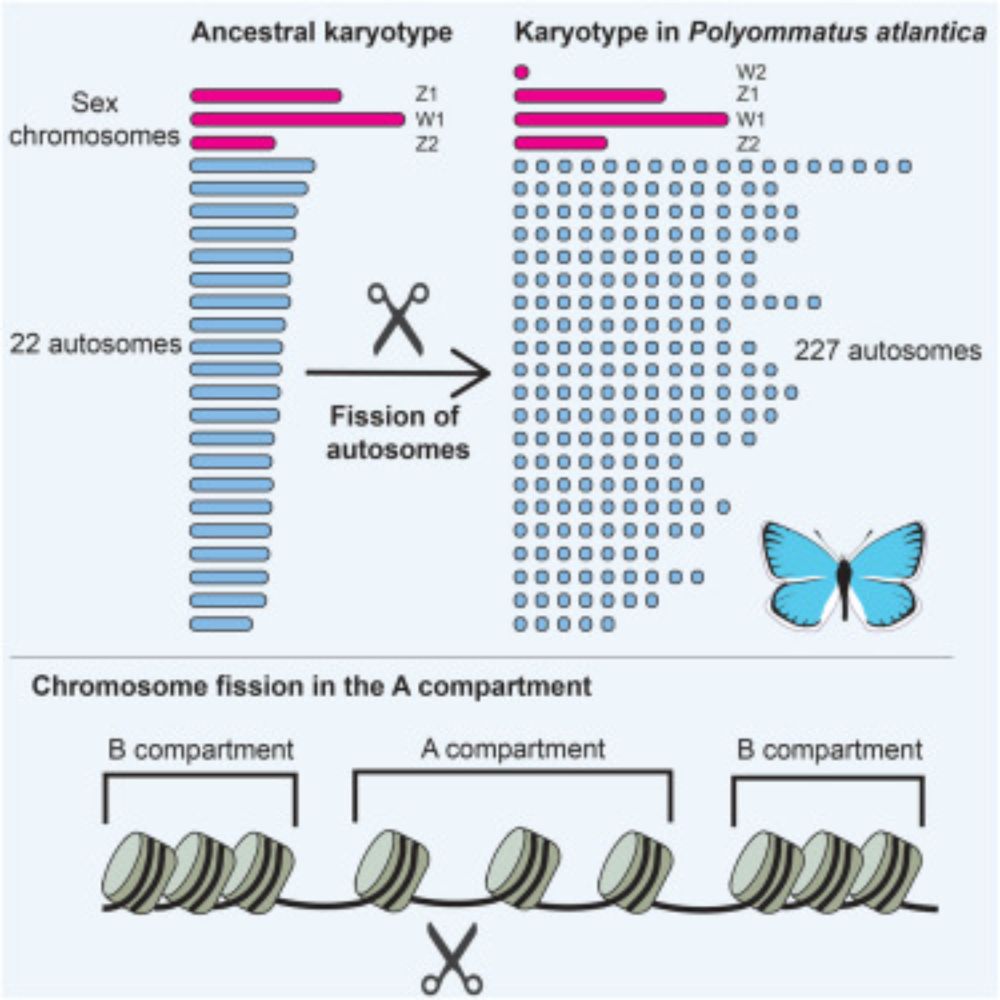
Many thanks to everyone who contributed — it was truly an incredible team effort. A real pleasure working with @tomlewin.bsky.social and @tosuke-s.bsky.social, and wonderful to close the circle together in Japan with Mayuko.
10.11.2025 17:44 — 👍 2 🔁 0 💬 0 📌 0

Lophophorata is monophyletic!
Super excited to see this work out in Current Biology - we sequenced a phoronid genome and used shared chromosome fusions to confirm the monophyly of Lophophorata.
A big team effort from the Luo Lab @yjluo.bsky.social!
More here: authors.elsevier.com/c/1m3mV3QW8S...
10.11.2025 14:37 — 👍 21 🔁 9 💬 2 📌 1
You can read our paper through this Share Link (available until December 27, 2025).
authors.elsevier.com/a/1m3mV3QW8S...
10.11.2025 09:21 — 👍 1 🔁 0 💬 0 📌 0
Synteny plots packed with detailed information can be hard to read. Here's a short animation showing how shared chromosomal fusions link phoronids and bryozoans.
10.11.2025 09:10 — 👍 2 🔁 0 💬 0 📌 0
Comparing phoronid and bryozoan genomes revealed seven irreversible "fusion-with-mixing" events—unique chromosomal signatures showing that phoronids and bryozoans are sister groups, finally resolving a century-old debate. (5/5)
07.11.2025 16:38 — 👍 4 🔁 1 💬 0 📌 0
To resolve this, we turned to genome structure. Together with colleagues in Japan and the UK, we sequenced the first chromosome-level phoronid genome using PacBio HiFi and 3D chromosome conformation (Hi-C). (4/5)
07.11.2025 16:38 — 👍 1 🔁 0 💬 0 📌 0
Within Lophotrochozoa, the relationships among these groups remained controversial. Phylogenomic studies have alternately placed bryozoans with entoprocts and cycliophorans—or as sisters to phoronids. Two competing hypotheses emerged: "Lophophorata" vs. "Polyzoa". (3/5)
07.11.2025 16:38 — 👍 1 🔁 0 💬 0 📌 0
For over a century, lophophorates were thought to be related to deuterostomes based on embryology. In 1995, Halanych et al. overturned this view, showing instead that they share a common ancestor with molluscs and annelids, forming the Lophotrochozoa. (2/5)
07.11.2025 16:38 — 👍 1 🔁 0 💬 0 📌 0
Some marine invertebrates have puzzled zoologists for over a century. Their features combine traits of very different animals—hard to classify by morphology or development. Among them is Lingula, a brachiopod Darwin called a "living fossil". (1/5)
07.11.2025 16:37 — 👍 1 🔁 0 💬 0 📌 0

Pleased to share our latest paper led by @tomlewin.bsky.social, now out in @currentbiology.bsky.social! We present the first chromosome-level genome of a phoronid and show that shared chromosomal fusions unite phoronids and bryozoans as sister groups.
www.cell.com/current-biol...
07.11.2025 16:20 — 👍 49 🔁 21 💬 7 📌 1

Upside-down jellyfish
Noémie Buratto and Eli Thoré introduce Cassiopea, a genus of jellyfish living invertedly
on the sea floor.
2025 spirit animal: the upside-down jellyfish
🪼🙃
Find out about their amazing biology here👇
www.cell.com/current-biol...
by Noémie Buratto& @elisjthore.bsky.social
04.11.2025 11:57 — 👍 14 🔁 3 💬 0 📌 0
New preprint! We unexpectedly discovered that some Caenorhabditis species delete parts of their somatic genome early in development, which fragments their chromosomes and eliminates key germline genes. Multiple lines of evidence suggest this bizarre process was present in the ancestors of C. elegans
28.10.2025 12:11 — 👍 47 🔁 17 💬 0 📌 0
Apply Now! Tenure-track Faculty Position in Marine Bioscience at the University of Florida's Whitney Lab. explore.jobs.ufl.edu/en-us/job/53...
20.10.2025 19:14 — 👍 6 🔁 9 💬 0 📌 0

Revised evolutionary relationships within Brachycera and the early origin of bicoid in flies
Mulhair et al. uncover a functional bicoid in non-cyclorrhaphan flies, pushing the
gene's origin back by ∼20 million years. Reassessing the Diptera phylogeny using the
largest dataset to date permits ...
Latest work out today in @currentbiology.bsky.social
We find the fly development gene bicoid is much older than previously thought (~20 million yrs older!) 🪰🧬
To pinpoint its origins we tackled the Diptera phylogeny, providing some resolution (many open questions remain).
🔗 tinyurl.com/2vyuevpy
17.10.2025 15:13 — 👍 49 🔁 22 💬 2 📌 2
How to swap the foot for a tentacle and vice versa? Find out in our new story featured in @dev-journal.bsky.social uncovering a transcription factor toggle switch behind the identity of Hydra's extremities.
01.10.2025 15:04 — 👍 16 🔁 4 💬 2 📌 0


Great pleasure hosting Jochen Rink @mpi-nat.bsky.social in Taipei with @tosuke-s.bsky.social and Tasuku—perfect weather, good hike, and great science chats on Elephant Mountain.
19.10.2025 14:09 — 👍 9 🔁 0 💬 0 📌 0

🥳 Congratulations to our postdoc, Dr. Anna Czarkwiani @aniaczark.bsky.social, on receiving the ERC Starting Grant @erc.europa.eu!
With €2 million in funding, Anna will explore the biology of gravisensation and uncover insights into related disorders. 🧠
#CMCBnews @tudresden.bsky.social #ERCStG
04.09.2025 10:13 — 👍 36 🔁 13 💬 9 📌 2

We're excited to share with everyone a preprint of our manuscript that resolves the cellular origins of the symbiosome in cnidarian-algal symbiosis through proteomics of the symbiosome, RNAi, and CRISPR/Cas9 experiments. ⬇️
www.biorxiv.org/content/10.1...
Read on below!
1/12 🧵
13.10.2025 21:59 — 👍 50 🔁 23 💬 3 📌 2

"Why sequence the #genome of every species? A view from evolutionary biology" Did you catch this amazing new review in our journal by @peterhox.bsky.social? REad it for FREE here now: www.cambridge.org/core/journal... @thembauk.bsky.social #dnasequencing #chromosome #mutation #evolution
26.09.2025 16:26 — 👍 11 🔁 7 💬 0 📌 0

Sir John Gurdon, 1933-2025 | Wellcome
A Nobel-winning scientist of great modesty and humour, John Gurdon died on 7 October. He made a discovery that opened up the field of cloning research, and created one of the best environments for res...
A Nobel-winning scientist of great modesty and humour, John Gurdon died on 7 Oct. Not only did he make a discovery that laid the foundations for stem cell research, he also created one of the best environments for research at the Wellcome/CRUK Gurdon Institute wellcome.org/news/sir-joh...
09.10.2025 13:39 — 👍 151 🔁 51 💬 5 📌 6

I am very happy to announce that the Echinox Lab will open in the BIOM unit at @obs-banyuls.fr in January 2026!! 🥳
We will use several echinoderm species to study animal body plan evolution.
🔽 Check our brand new lab website if you want to learn more about our future research
www.echinox.org
10.09.2025 20:48 — 👍 66 🔁 10 💬 10 📌 2

Happy to share the Biodiversity Cell Atlas white paper, out today in @nature.com. We look at the possibilities, challenges, and potential impacts of molecularly mapping cells across the tree of life.
www.nature.com/articles/s41...
24.09.2025 15:12 — 👍 221 🔁 106 💬 3 📌 10

Non-CG DNA methylation in animal genomes
Nature Genetics - This Review discusses noncanonical DNA methylation (mCH) in animal genomes and highlights the remaining need to clarify whether mCH represents a conserved regulatory layer or a...
Very happy to have contributed to this review on "non-CG" #methylation in animals now out in @natgenet.nature.com. Working again with @obog.bsky.social and Tirsa is always a pleasure. We think this not so well studied form of methylation should be more widely considered, please read: rdcu.be/eFAEk
11.09.2025 10:11 — 👍 44 🔁 16 💬 2 📌 1

Latest from ours: www.cell.com/cell-reports...
This is two stories in one: a case study/cautionary tale on developing genetic tools in new organisms, and the first hint at a gene regulatory network for choanoflagellate multicellular development (which turn out to involve a Hippo/YAP/ECM loop!) A 🧵
05.10.2025 10:35 — 👍 240 🔁 100 💬 10 📌 10

A white-fronted bee-eater (Merops bullockoides) decides whether to consume a warningly colored white-barred acraea butterfly (Telchinia encedon). Photo (c) Mike Rowe
📢🦋 Our paper ‘Global selection on insect antipredator coloration’ is out and featured on the cover of @science.org
We ran a huge experiment to find out how ecological context favours camouflage and warning colouration as antipredator strategies. 1/6
www.science.org/doi/10.1126/...
25.09.2025 18:25 — 👍 131 🔁 52 💬 3 📌 6

Evolutionary age correlates with range size across plants and animals - Nature Communications
Why are some species widespread while others are found only in small, isolated areas? This study shows that species with narrow ranges, and thus higher extinction risk, are often island-restricted, poor dispersers, and have evolved relatively recently.
Why are some species widespread while others are found only in small, isolated areas? A study in Nature Communications shows that species with narrow ranges, and thus higher extinction risk, are often island-restricted, poor dispersers, and have evolved relatively recently. #evosky 🧪
17.09.2025 01:39 — 👍 53 🔁 13 💬 0 📌 0

Constraints on chromosome evolution revealed by the 229 chromosome pairs of the Atlas blue butterfly
The genome of the Atlas blue butterfly contains ten times more chromosomes than most
butterflies, and more than any other known diploid animal. Wright et al. show that
this extraordinary karyotype is ...
How many chromosomes can an animal have?
In our paper out now in @currentbiology.bsky.social we show that the Atlas blue butterfly has 229 chromosome pairs- the highest in diploid Metazoa! These arose by rapid autosome fragmentation while sex chromosomes stayed intact.
www.cell.com/current-biol...
11.09.2025 15:21 — 👍 210 🔁 99 💬 4 📌 6

Genetic parallels in biomineralization of the calcareous sponge Sycon ciliatum and stony corals
Discovery of calcarins in calcareous sponges highlights gene duplication and neofunctionalization as drivers of parallel biomineralization, offering insight into the independent evolution of calcifica...
🧪Discovery of calcarins in @elife.bsky.social, a protein family in the sponge Sycon ciliatum, clarifies spicule formation and suggests parallel evolution of carbonate biomineralization in sponges & corals—key for animals as ecosystem engineers of reefs.
@lmumuenchen.bsky.social
#molpalmuc
09.09.2025 11:07 — 👍 12 🔁 7 💬 1 📌 0
Fungi 🍄 | Plants 🌵 | Epigenetics 🧬 | Eco-Evo-Devo 🌀 | PhD Student, Stanford 🌲(he/him/il) #FirstGen #QueerinSTEM 🏳️🌈
🌎 Science is for everyone.
🍄🟫 Views are my own.
Associate Professor at the Univerisity of Bologna. Past Maynooth, Oxford, Caltech, Bristol, Leicester and URF Webpage: https://sites.google.com/view/feudalab/home?authuser=0
🧬🦪🦗🧽 Dealing/struggling with invertebrate evolutionary genomics
🎓 he/him postodoc in @robertofeuda.bsky.social lab at Uni of Leicester (UK), former PhD student at Uni of Bologna (IT)
🎨💭 Also drawing & communicating science
https://filonico.github.io/
PI in Academia Sinica at Taipei. Specialized cells in plants, evolution of transcription factors, cell differentiation. Running, trail running, and karate.
PhD student at UConn || UPRH Alumni || NSF GRFP Fellow ||Inverts, Genomics, Evolution and Science Communication || 🇵🇷🏳️🌈
Postdoctoral researcher at UC Berkeley | Microalgae, environmental stress, molecular and synthetic biology | Formerly @ Université Paris Sud, Sorbonne Université, AgroParisTech, and ISA Lille.
https://scholar.google.com/citations?user=f5eOF_YAAAAJ
Bioinformatics, protein modeling, cryoEM, drug screening, function prediction. Daisuke Kihara, professor of Biol/CS, Purdue U. https://kiharalab.org/ YouTube: http://alturl.com/gxvah
Paleobiologist interested in fossil bryozoans. He/Him - I study the living beings of the past to understand the problems of the present.
Interested in chromatin dynamics during mammalian development
Interested in mobile DNA and genome evolution, mostly working with eukaryotic algae.
Lecturer in Genomics at the University of Melbourne.
PhD candidate at Clark University. All about embryos, neurons and evolution. 🇵🇪🏳️🌈 #embryo25
Professor of Marine Ecology at GEOMAR / Kiel University, trained ecoevophysiologist, interested in coastal invertebrates, algae & climate change.
Assistant Professor at University of Texas at San Antonio. Study evolution/regulation of selfish genes. Manage two labs. Research lab🔬🧪🧬🖥️ with some ease but the other lab 🐶🐾 is un-manageable!
https://www.anti-sense.org/
Evolutionary cell biology @EMBL
evonuclab.org
Official account of The Molecular Biology Society of Japan (MBSJ).
日本分子生物学会の公式アカウントです。
MBSJ Website:
EN https://www.mbsj.jp/en/
JP https://www.mbsj.jp/
Professor, USC Marine and Environmental Biology, microbe hunter. he/him. Not a bot. thethrashlab.com
Associate Professor of Microbiology @UniNMBU, Norway. Fond of carb degradation by gut #microbiomes, #multiomics, #CAZymes,#prebiotics. Editorial Board Member @CommsBio. Italian 🇮🇹 via 🇺🇸 to 🇳🇴
Macroevolution, paleobiology, Singapore-grown, US-developed scientist in Norway. Marine inverts, bryozoans. Natural History Museum & Centre for Planetary Habitability Oslo.
[Background photo is the Whanganui coast, North Island, NZ]
Associate Professor and ERC Starting Awardee at University of Galway! I work on early animal evolution with a particular interest in gene regulation and chromatin!
https://gahanlab.com
https://chromosome.ie/groups/gahan/
🏳️🌈🇮🇪 He/Him
How do organs form from cells to tissue? Zebrafish and organoids; live imaging; quantitative biology; theory. Comments by Caren Norden





















